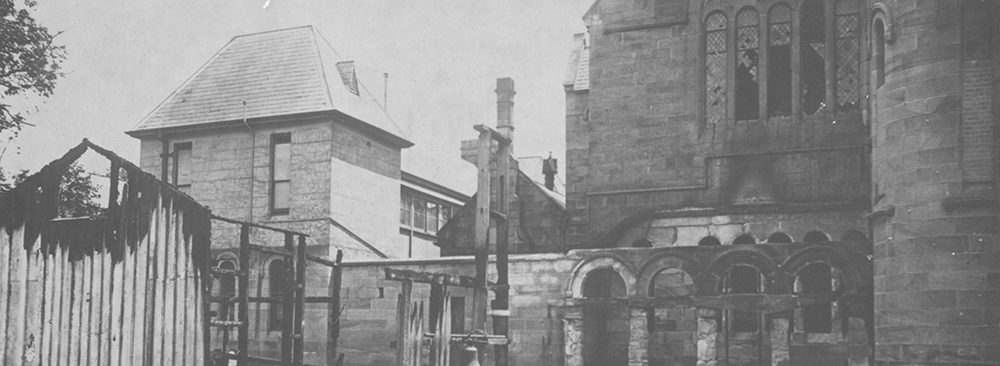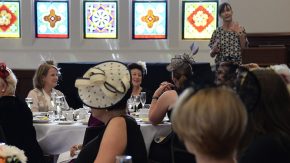Fire!
At about 11:30 PM on Tuesday night, 17 November 1916, Mr Taylor, a member of the Newington staff, was returning to the College after an evening out when he saw the lurid glare of flames behind the main College building (now the Founders Building). Wooden buildings, located where the Technology and Design Centre now stands, were well alight and threatening the main building.
Once alerted, Headmaster Rev Charles Prescott telephoned the Fire Brigade. Meanwhile, attempts to prevent the blaze from spreading with buckets of water proved futile. By the time fire trucks from the Petersham Fire Station arrived, soon joined by units from Marrickville and Newtown, the fire was spreading to the spiral stair (approximately where the staircase between the Nesbitt Centre and Founders now stands) and the assembly room next to the School Room (now the Prescott Hall). It took some time to extinguish the blaze.
The biggest concern was the safety of the boarders: at this time, the first and second floors of Founders contained the boarders’ accommodation. At first, contrary to modern practice, the boys were ordered to remain quiet in their rooms, but it was quickly realised that an evacuation was required. The task was made more difficult by the darkness and the amount of smoke in the building: it was reported that, ‘though the gas was burning downstairs’ [the gas lighting representing another danger], ‘it was barely possible to see more than three or four steps in front of one.’ Remarkably, the boys took their belongings — ‘trunks, bags, clothes and uniforms’ — from the box rooms as they evacuated. They assembled on the lawn in front of Founders, but quickly joined the crowd of neighbours and soldiers from the nearby Addison Road Camp watching the scene.
The wooden buildings at the centre of the fire, containing the bicycle lockers and the Sports Room, were destroyed. Besides boarders’ bicycles, many lost clothes, books and notes here. The Sports Room contained ‘a large amount of new cricket material’, all of which were completely destroyed. Besides the damage to the spiral stair and assembly room, the boot room and the dining room, on the ground floor at the rear of Founders, suffered significant damage. ‘Great quantities of plaster had fallen from the walls, the ceiling was scorched and warped by the heat, and, worst of all, the Honour photographs in their frames were severely damaged,’ The Newingtonian reported. There was also damage from heat, smoke and water to other nearby parts of the building, notably the Prescott Hall. The broken windows at the end of the hall are clearly visible in the photograph of the aftermath that accompanied the report.
The cause of the fire remained a mystery. While some fancifully blamed the Industrial Workers of the World, whose members had been accused of a number of arson attacks in Sydney that year, the suggestion that a spark from the nearby incinerator started the blaze seems a more likely explanation.
David Roberts
College Archivist






